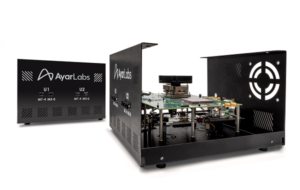 SANTA CLARA, Calif. – March 1, 2023 – Silicon photonics company Ayar Labs today announced what it said is the first demonstration of 4 terabit-per-second (Tbps) bi-directional Wavelength Division Multiplexing (WDM) optical technology.
SANTA CLARA, Calif. – March 1, 2023 – Silicon photonics company Ayar Labs today announced what it said is the first demonstration of 4 terabit-per-second (Tbps) bi-directional Wavelength Division Multiplexing (WDM) optical technology.
The demonstration will take place at the Optical Fiber Communication Conference (OFC) in San Diego on March 5-9, 2023, Ayar Labs said. The company will show its optical I/O solution moving data from one of its TeraPHY optical I/O chiplet to another at 2.048 Tbps each direction powered by their SuperNova light source, according to the company.
SuperNova powers 8 fiber links (using 64 wavelengths operating at 32 Gbps, for 256 Gbps per individual fiber) running error free at lower than 10ns of latency and without needing Forward Error Correction (FEC) for a total bandwidth of 2.048 Tbps each direction, or 4.096 Tbps bi-directional. Ayar Labs also said the data transfer is using less than 5 pJ/bit (10W) energy efficiency, “providing the power density and performance per watt needed to achieve trillions of AI parameters, advanced HPC designs and more.”
“In-package optical I/O solutions have the potential to transform how semiconductor, AI, HPC and aerospace customers process their next-generation, data-intensive workloads,” said Craig Thompson, vice president of Business Development for Networking at NVIDIA, which announced a development partnership with Ayar Labs in May 2022.. “NVIDIA’s accelerated computing platform is enabled by advanced technologies such as WDM optical interconnects to equip tomorrow’s innovators with the extreme performance they need.”
In its announcement, the company said “In-package optical I/O uniquely changes the power and performance trajectories of system design by enabling compute, memory and network silicon to communicate with a fraction of the power and dramatically improved performance, latency and reach versus existing electrical I/O solutions. Delivered in a compact, co-packaged CMOS chiplet, optical I/O becomes foundational to next-generation AI, disaggregated data centers, dense 6G telecommunications systems, phased array sensory systems and more.”

“Revenue generated by the Co-Package Optics (CPO) market for high performance computing (HPC) was around US$5 million in 2022 and is expected to reach US$2.3 billion in 2033 with a 74 percent compound annual growth rate for 2022-2033,” said Martin Vallo, senior analyst, photonics, at Yole Intelligence, part of Yole Group. “Projections of rapidly growing training dataset sizes underline that data will become the main bottleneck for scaling machine learning models. As a result, we might see a slowdown in AI progress. Using optical I/O in ML hardware can help overcome the unfavorable result of this analysis. This could be the main driver for the adoption of optical interconnects for next-gen HPC systems.”
Ayar Labs said it works with high-volume manufacturing and supply partners including GlobalFoundries, Lumentum, Macom, Sivers Photonics and others to deliver the optical interconnects needed for data-intensive applications. Separately, the company was featured in an announcement with Quantifi Photonics on a CW-WDM-compliant test platform for its SuperNova laser, also at OFC.




